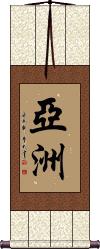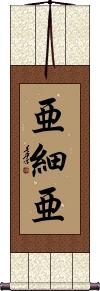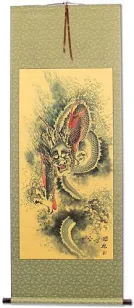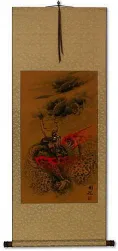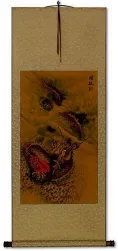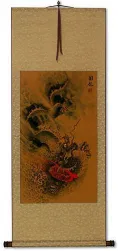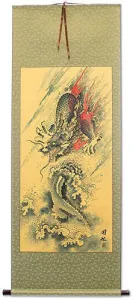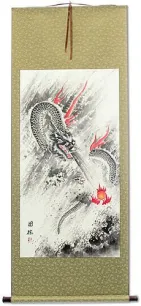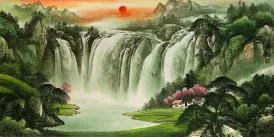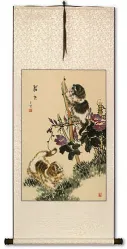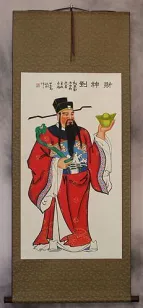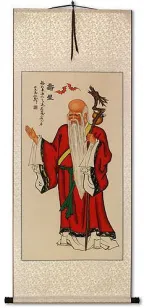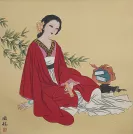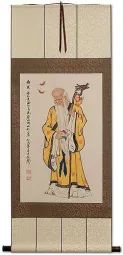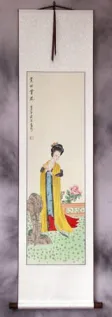Many custom options...
And formats...

Asian in Chinese / Japanese...
Buy an Asian calligraphy wall scroll here!
Personalize your custom “Asian” project by clicking the button next to your favorite “Asian” title below...
Asian Pride / Oriental Pride / AZN Pryde
東方自尊 is the universal way to write “Asian Pride.”
We worked on this one for a long time. The effort involved both Chinese and Japanese translators and lengthy discussions. If you have been searching for this term, there is a reason that it's hard to find the way to write “Asian Pride” in Chinese and Japanese - it's because of the inherent difficulties in figuring out a universal combination of characters that can be read in all languages that use forms of Chinese characters.
This final solution that you see to the left creates a reasonable title in Chinese and an exotic (perhaps unusual) title in Japanese (This could be read as “Eastern Self-Respect” in Japanese”).
Although not as natural, it does have the same meaning as Korean Hanja, and the older generation of Vietnamese people will be able to read it.
The first two characters literally mean “Oriental” and the second two mean “pride,” “self-esteem,” or “self-respect” (we chose the most non-arrogant way to say “pride”). If you have “Asian Pride” (sometimes spelled Asian Pryde) these are the characters for you.
Note: For those who wonder, there is nothing technically wrong with the word “Oriental.” It is a correct word, and any bad meanings were created by so-called “Asian Americans” and Caucasians in the United States. To say “Asian” would not completely correct the intended meaning since that would include people from Saudi Arabia, Iraq, Iran, India, and portions of Russia.
For further proof, if you were of East Asian ancestry and born in England, you would be known as a “British Oriental” (The “Oriental stigma” is basically an American creation and, therefore, applies mainly to the American English language - where they get a bit overzealous with political correctness).
Further, since the Chinese and Japanese word for Oriental is not English, they can not be construed as having ill meaning. On one trip to China or Japan, you will find many things titled with these two characters, such as malls, buildings, and business names. These places also use “Oriental” as their English title (much as we do since our Chinese business name starts with these same two characters).
In short, the first two characters have the meaning that Americans attach to “Asian” but is more technically correct.
Asia / Asian Continent
Asia / Asian Continent
Double Happiness Guest Book
Customize a special Asian guest book for your wedding
Start customizing a “Double Happiness Guest Book Wall Scroll” Here!
The paper panel length can be whatever you choose from 68cm to 135cm (27” to 53”).
If you don't mention what paper length you want in the special instructions tab (on the next page), we'll make it about 100cm (40”).

The medium-size scroll with a 33cm x 100cm (13” x 40”) paper panel can usually handle up to 89 signatures. That breaks down to 37 signatures per empty square and 15 signatures around the 囍 character. If you switch to a 135cm paper panel, add another 37 potential signatures.
We can splice two 135cm papers together, but that would be a crazy-long scroll. These are only estimates, your mileage may vary.
With silk panels, this will yield a wall scroll about 155cm (61”) long. That's enough for up to 89 signatures. Of course, that depends on if your guests just sign a brief salutation and name, or more verbose good wishes. Customer feedback is that 126 people can sign the 135cm long paper on a medium-sized scroll. If we go bigger than that, there will be a minor paper seam and an extra charge. Email me with your specifications if you need something special.
Most customers pick the festive red paper with gold flecks and white or ivory silk. Red is a good luck color in Chinese culture, thus the most popular choice. But, you can do any color combination that you want.
There is a long history of Chinese-character-use outside of mainland China. This Double Happiness character is also seen at weddings in Korea, Vietnam, Hong Kong, and Taiwan, as well as in Chinese communities in Thailand, Indonesia, and elsewhere. While Japan borrowed Chinese characters into their language, you won't see 囍 as often at Japanese weddings.
This in-stock artwork might be what you are looking for, and ships right away...
Gallery Price: $220.00
Your Price: $138.88
Gallery Price: $300.00
Your Price: $138.88
Not the results for Asian that you were looking for?
Below are some entries from our dictionary that may match your Asian search...
| Characters If shown, 2nd row is Simp. Chinese |
Pronunciation Romanization |
Simple Dictionary Definition |
律 see styles |
lǜ lu:4 lü ritsuji りつじ |
More info & calligraphy: Ritsu(1) law (esp. ancient East Asian criminal code); regulation; (2) {Buddh} vinaya (rules for the monastic community); (3) (abbreviation) (See 律宗) Ritsu (school of Buddhism); (4) (abbreviation) (See 律詩) lüshi (style of Chinese poem); (5) (also りち) (musical) pitch; (6) (See 十二律,呂・2) six odd-numbered notes of the ancient chromatic scale; (7) (abbreviation) (See 律旋) Japanese seven-tone gagaku scale, similar to Dorian mode (corresponding to: re, mi, fa, so, la, ti, do); (n,n-suf,ctr) (8) step (in traditional Eastern music, corresponding to a Western semitone); (personal name) Ritsuji vinaya, from vi-ni, to 1ead, train: discipline: v. 毘奈耶; other names are Prātimokṣa, śīla, and upalakṣa. The discipline, or monastic rules; one of the three divisions of the Canon, or Tripiṭaka, and said to have been compiled by Upāli. |
ナン see styles |
nan ナン |
More info & calligraphy: Nunn |
南京 see styles |
nán jīng nan2 jing1 nan ching nankin なんきん |
More info & calligraphy: Nanjing(1) Nanjing (China); Nanking; (2) (ksb:) (See カボチャ) pumpkin; squash; (prefix noun) (3) Chinese; Southeast Asian; foreign; (prefix noun) (4) rare; precious; cute; (place-name) Nanking (China); Nanjing |
希爾 希尔 see styles |
xī ěr xi1 er3 hsi erh |
More info & calligraphy: Shear |
水牛 see styles |
shuǐ niú shui3 niu2 shui niu zungyou / zungyo ずんぎょう |
More info & calligraphy: Water Ox/Bull(1) water buffalo (Bubalus bubalis); domestic Asian water buffalo; (2) wild water buffalo (Bubalus arnee); Asian water buffalo; (place-name) Zungyou |
アジア see styles |
ajia アジア |
More info & calligraphy: Azia |
ビグル see styles |
biguru ビグル |
picul (Asian unit of weight, approx. 60 kg); (personal name) Biggle |
眼鏡蛇 眼镜蛇 see styles |
yǎn jìng shé yan3 jing4 she2 yen ching she meganehebi めがねへび |
More info & calligraphy: Cobraspectacled cobra; Indian cobra; Asian cobra (Naja naja) |
漆 see styles |
qī qi1 ch`i chi shitsu しつ |
paint; lacquer; CL:道[dao4]; to paint (furniture, walls etc) (1) East Asian lacquer; japan; (2) (kana only) Chinese lacquer tree (Toxicodendron vernicifluum, formerly Rhus verniciflua); (surname) Shitsu Varnish, lacquer. |
祆 see styles |
xiān xian1 hsien ken |
Ahura Mazda, the creator deity in Zoroastrianism Xian, commonly but incorrectly written 祅 a Western Asian name for Heaven, or the 天神 God of Heaven, adopted by the Zoroastrians and borrowed later by the Manicheans; also intp. as Maheśvara. |
笠 see styles |
lì li4 li riyuu / riyu りゆう |
bamboo rain hat (1) conical hat (East-Asian style); coolie hat; (2) (See 傘・かさ・2) something shaped like a conical hat or an umbrella; shade (of a lamp); mushroom cap; pileus; (personal name) Riyū |
魾 see styles |
pī pi1 p`i pi |
Bagarius, an Asian genus of catfishes |
亀茲 see styles |
kyuushi / kyushi きゅうし |
(place-name) Kucha (ancient Central Asian kingdom) |
于闐 于阗 see styles |
yú tián yu2 tian2 yü t`ien yü tien Uten |
于遁; 于殿; 于塡; 谿丹; 屈丹; 和闐; 澳那; 瞿薩憺那 Kustana, or Khotan, in Turkestan, the principal centre of Central Asian Buddhism until the Moslem invasion. Buddhism was introduced there about 200 B.C. or earlier. It was the centre from which is credited the spread of Mahayanism, v. 西城記 12. |
亞裔 亚裔 see styles |
yà yì ya4 yi4 ya i |
of Asian descent |
亞運 亚运 see styles |
yà yùn ya4 yun4 ya yün |
Asian Games |
人参 see styles |
ninjin(p); ninjin にんじん(P); ニンジン |
(1) (kana only) carrot (Daucus carota); (2) (kana only) (See 朝鮮人参) Asian ginseng (Panax ginseng) |
匈奴 see styles |
xiōng nú xiong1 nu2 hsiung nu kyoudo; funnu / kyodo; funnu きょうど; フンヌ |
Xiongnu, a people of the Eastern Steppe who created an empire that flourished around the time of the Qin and Han dynasties (hist) Xiongnu (ancient Central Asian nomadic people associated with the Huns) |
南蛮 see styles |
nanban なんばん |
(1) (hist) (derogatory term) southern barbarians (name used in ancient China for non-Chinese ethnic groups to the south); (2) (hist) South-East Asian countries (in the late-Muromachi and Edo periods); (3) (hist) Western Europe (esp. Spain and Portugal and their South-East Asian colonies; late-Muromachi and Edo periods); (prefix noun) (4) (hist) foreign (of goods from South-East Asia and Western Europe); exotic (esp. in a Western European or South-East Asian style); (5) (See 唐辛子・1) chili pepper; (6) (abbreviation) {food} (See 南蛮煮・2) nanban; dish prepared using chili peppers and Welsh onions; (7) thrusting the right foot and right arm forward at the same time (or left foot and left arm; in kabuki, dance, puppetry, etc.) |
唖蝉 see styles |
oshizemi おしぜみ |
voiceless cicada (female); Asian cicada |
噪鵑 噪鹃 see styles |
zào juān zao4 juan1 tsao chüan |
(bird species of China) Asian koel (Eudynamys scolopaceus) |
外専 see styles |
gaisen がいせん |
(derogatory term) (slang) (abbreviation) (abbr. of 外(国)人専門) gaijin hunter; person who only dates (non-Asian) foreigners |
寒鯛 see styles |
kandai かんだい |
(1) (kana only) Asian sheepshead wrasse (Semicossyphus reticulatus); (2) scarbreast tuskfin (Choerodon azurio) |
山桃 see styles |
yamamomo; yamamomo やまもも; ヤマモモ |
(kana only) wax myrtle (Myrica rubra); asian bog myrtle |
岩燕 see styles |
yán yàn yan2 yan4 yen yen iwatsubame; iwatsubame いわつばめ; イワツバメ |
(bird species of China) Eurasian crag martin (Ptyonoprogne rupestris) (kana only) Asian house martin (Delichon dasypus) |
川蛇 see styles |
kawahebi かわへび |
(rare) (See 田鰻) Asian swamp eel (Monopterus albus) |
数え see styles |
kazoe かぞえ |
(abbreviation) (See 数え年・かぞえどし,満・まん・2) East Asian age reckoning; traditional system of age reckoning whereby newborns are considered one year old and on New Year's Day one year is added to everyone's age |
早操 see styles |
zǎo cāo zao3 cao1 tsao ts`ao tsao tsao |
morning exercises (physical exercises commonly performed en masse at schools and workplaces in East Asian countries) |
普氏 see styles |
pǔ shì pu3 shi4 p`u shih pu shih |
Nikolai Mikhailovich Przevalski 普爾熱瓦爾斯基|普尔热瓦尔斯基 (1839-1888), Russian explorer who made four expeditions to Central Asian from 1870 |
書道 see styles |
shodou / shodo しょどう |
(See カリグラフィー) calligraphy (esp. Asian calligraphy based on Chinese characters) |
Click here for more Asian results from our dictionary
The following table may be helpful for those studying Chinese or Japanese...
| Title | Characters | Romaji (Romanized Japanese) | Various forms of Romanized Chinese | |
| Asian Pride Oriental Pride AZN Pryde | 東方自尊 东方自尊 | tou hou zi son touhouzison to ho zi son | dōng fāng zì zūn dong1 fang1 zi4 zun1 dong fang zi zun dongfangzizun | tung fang tzu tsun tungfangtzutsun |
| Asia Asian Continent | 亞洲 亚洲 | yà zhōu / ya4 zhou1 / ya zhou / yazhou | ya chou / yachou | |
| Asia Asian Continent | 亜細亜 | a ji a / ajia | ||
| Double Happiness Guest Book | 囍 喜喜 | xǐ / xi3 / xi | hsi | |
| In some entries above you will see that characters have different versions above and below a line. In these cases, the characters above the line are Traditional Chinese, while the ones below are Simplified Chinese. | ||||
Successful Chinese Character and Japanese Kanji calligraphy searches within the last few hours...

